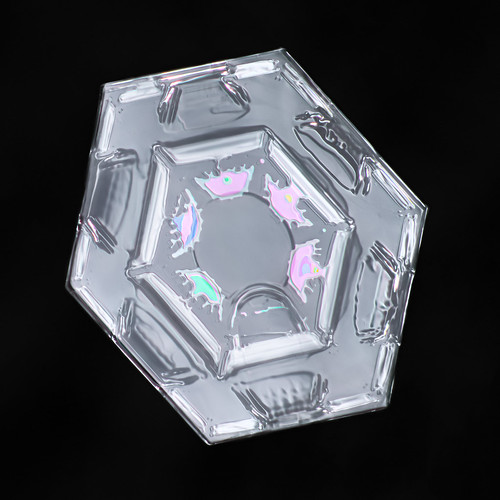
Not unlike the “stargates” of the similarly named science fiction series, this snowflake appears to be a portal to another world. The beautifully colourful patterns were once a mystery to me, but thankfully can be explained on these 1mm-diameter crystals.
Thin film interference. It’s the same physics that allows for colours to be seen in soap film and oil spots, but I have also seen it in other fluids as well – but rarely a solid. Snowflakes are the only one I can think of. With a bubble of air trapped close to the surface of ice, the extreme thinness of the ice and air can evoke this phenomenon – and it’s pretty simple.
A prism splits white light into colours because light slows down when passing through a denser medium, and the longer it is in the prism, the more it is slowed down, separating colours. This is different, but still relies on the fact that light slows down when passing through the ice. Some light reflects off of the front surface, never slowing down. Some light enters into the ice but reflects off of the surface of the bubble, heading back on the same trajectory to the camera. When it rejoins the light that did not slow down, it is now “out of sync”, which causes an interference pattern to emerge. Some light waves interact destructively, disrupting white light into specific colours.
Where a soap bubble is a fluid, moving mix of colours based on the thickness of the soap film, a snowflake has static colours – but they still shift in colour based on the thickness of the bubble and the surrounding ice. Vary the thickness, change the colour. These likely resulted from the “fill in” bubble formation I have previously described, creating a thin ceiling of ice over a valley of various contours below.
Such tiny snowflakes can be difficult to photograph. Shot at 5x magnification on a Lumix S1R, 47MP gives enough resolution to crop in, and achieve the level of detail you see. I had previously been able to add extension tubes and additional optics to increase magnification, but the optical resolution suffers greatly. At times I have gone to the extreme length of shooting with a 20x microscope objective, handheld in the cold winter weather… however, I don’t wish that task on anyone!
In the end, snowflakes continue to prove one important thing: they are an intersection of art and science. We see them as beautiful constructs of nature, created with some simple rules of physics – of which the vast majority of their beauty is never seen. The more you can appreciate the beauty in a single snowflake, the more beautiful the world becomes.
For a full tutorial on the ins and outs of snowflake photography, including how to shoot with microscope objectives (if you dare), you can read about it in my upcoming book: skycrystals.ca/product/pre-order-macro-photography-the-un...
Posted by Don Komarechka on 2021-03-18 12:25:42
Tagged: , snowflake , snow , flake , ice , crystal , nature , natural , hexagon , color , colour , thin film interference , weather , meteorology , water , frozen , mineral , mineralogy , symmetry , fractal , physics , science , macro , focus stacking , lumix , S1R , LumixS1R , geometry , sky
Auto Amazon Links: No products found. No products found. http_request_failed: A valid URL was not provided. URL: https://ws-in.amazon-adsystem.com/widgets/q?SearchIndex=All&multipageStart=0&multipageCount=20&Operation=GetResults&Keywords=hexagon|snow|natural|snowflake|frozen&InstanceId=0&TemplateId=MobileSearchResults&ServiceVersion=20070822&MarketPlace=IN Cache: AAL_43a0cc82bbdda56771b495094b424a65






